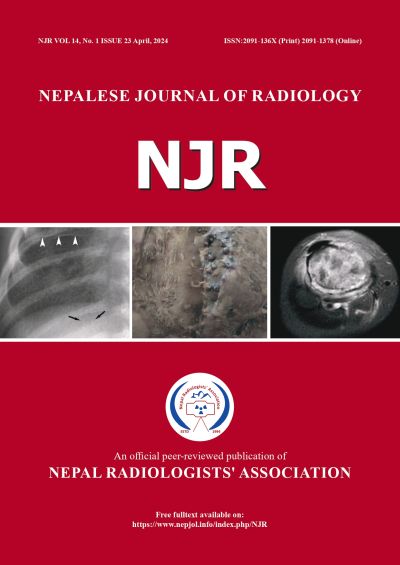Radiographic Evaluation of Neonatal Respiratory Distress: Cross-Sectional Study on Chest X-ray Findings in the Neonatal Intensive Care Unit
DOI:
https://doi.org/10.3126/njr.v14i1.64624Keywords:
Lung, Pleural Effusion, Radiation Exposure, Respiratory Distress Syndrome, TomographyAbstract
Introduction: Neonatal Respiratory distress (NRD) is a common reason for admission to the Neonatal Intensive Care Unit (NICU). While clinical diagnosis is essential, imaging evaluation can help confirm lung lesions, their extent, and associated abnormalities. However, radiation exposure from imaging modalities such as Computed Tomography (CT) and Chest X-ray (CXR) is a concern, particularly for neonates. This study aims to identify the various CXR findings in neonates with respiratory distress in the NICU.
Methods: A quantitative cross-sectional study was conducted on 59 neonates with respiratory distress in the NICU from November 2019 to November 2020. Ethical clearance was obtained, and data were collected through portable CXR. The collected data were analyzed using Microsoft Excel 2016 and Statistical Package of Social Services (SPSS) IBM version 23.
Results: CXR findings of 59 neonates with a mean age of 15.9 ± 7.4 days were evaluated. The majority were premature neonates, and the most common clinical diagnosis was respiratory distress syndrome (RDS). Hypoaeration was the most common finding in lung fields, followed by normal aeration. Parenchymal changes were observed in most cases, with reticulations/haziness being the most common, followed by consolidation. Pleural effusion was seen in a few cases, predominantly in preterm neonates with RDS.
Conclusions: The study underscores the prevalence of hypoaeration, reticulations, and consolidations in NICU patients with RDS, emphasizing the importance of early diagnosis and future research in neonatal chest imaging for respiratory distress.
Downloads
Downloads
Published
How to Cite
Issue
Section
License
Copyright (c) 2024 Nepalese Journal of Radiology

This work is licensed under a Creative Commons Attribution-NonCommercial 4.0 International License.
This license enables reusers to distribute, remix, adapt, and build upon the material in any medium or format, so long as attribution is given to the creator. The license allows for commercial use.




